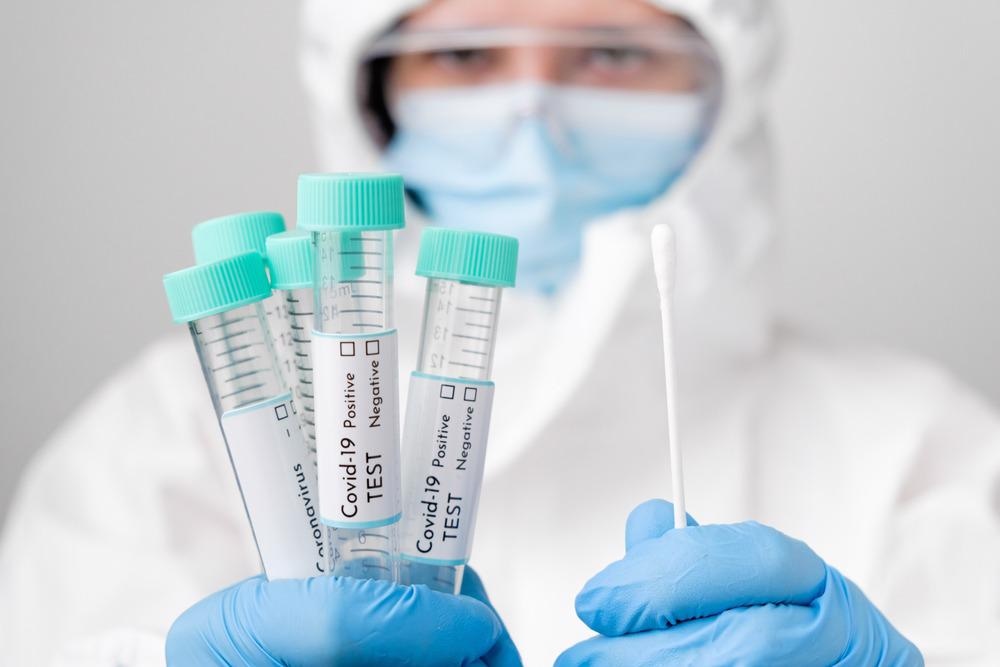With the outbreak of the severe acute respiratory coronavirus 2 (SARS-CoV-2) infection still a global health concern, researchers have been finding innovative methods to detect this virus.

Study: COVID-19 Diagnosis by SARS-CoV-2 Spike Protein Detection in Saliva Using an Ultrasensitive Magneto-assay Based on Disposable Electrochemical Sensor. Image Credit Vladimka production/Shutterstock.com
A preprint article to be published in the journal, Sensors and Actuators: B. Chemical, involves a team of researchers focused on diagnosing the SARS-CoV-2 virus within saliva samples using ultrasensitive magneto-assay based on disposable electrochemical sensors.
Why Are New Tests Necessary?
The SARS-CoV-2 infection was first introduced almost two years ago, evolving into a pandemic in March 2020 as determined by the World Health Organization (WHO). While there have been more than 230 million cases since its first outbreak, the infection has wrought burdens on society spreading across countries worldwide.
The WHO proposed nucleic acid amplification tests as the most sensitive and specific type of testing for bacterial or viral detection. However, while these tests are effective, they do have limitations such as high costs which prevent ubiquitous use. This is especially the case within low- and middle-income countries that may not be able to afford diagnostic tests, which aids the transmissibility of the virus. Additionally, these tests are time-consuming and require highly qualified personnel, a disadvantage for large events, international travel, and even ensuring health checks before returning to work.
These limitations resulted in a different alternative recommended by WHO – viral antigen tests. These tests aim to detect viral RNA through the reverse transcription-polymerase chain reaction (RT-PCR) technique and have become the primary method used for diagnosing coronavirus disease 2019 (COVID-19).
While this technique is considered to be the gold standard for the detection of the SARS-CoV-2 virus, its limitations have brought researchers to explore other avenues and novel detection methods.
The high volume of infection cases due to the transmissibility of this virus has caused a dependence on this the RT-PCR test and with drawbacks such as accessibility, costly equipment and time-consuming nature, the need to develop a novel test to reduce the limitations attached to a test which is so frequently required, has become paramount.
Targeting the Spike Protein
In the best interest of public health, researchers have focused on the spike protein within the SARS-CoV-2 infection to develop new alternative detection methods of viral antigens.
The spike protein consists of a receptor-binding domain, (RBD) and a fusion domain. The RBD domain binds to the human angiotensin-converting enzyme 2 (ACE2) receptor, a critical point that results in the entry of the SARS-CoV-2 virus into the host cells. Additionally, the fusion domain fuses the host cell and viral membranes through the C-terminal S2 subunit.
The significance of the spike protein has led researchers to target this protein to prevent this interaction and stop the entry into the host cell and the transmissibility of this virus.
Developing a Novel COVID-19 Test
A group of innovative researchers has combined nanotechnology with creating a diagnostic tool to aid in detecting the SARS-CoV-2 spike protein within saliva.
The team developed an ultrasensitive magneto-assay where they included an excitingly novel component, magnetic beads, and gold nanoparticles, which were conjugated to human angiotensin-converting enzyme 2 (ACE2) peptide. This was used for detecting a critical protein the SARS-CoV-2 virus is known for – its spike protein.
This novel innovation utilized a disposable electrochemical device that held eight screen-printed carbon electrodes which allow for simultaneous analysis of eight samples.
The test was found to have an ultra-low limit of detection for the spike protein within saliva standing at, 0.35 ag mL−1. The researchers illustrate the potential of this advanced detection method, proposing a sensitivity of 100.0%, as well as having a specificity of 93.7%.
This is similar to the RT-PCR test and so using this alternative test would not compromise efficacy in detection levels. However, without lengthy steps such as RNA extractions or thermal cycling as well as long analysis time, this novel test would improve the cost associated and the time taken, with simple preparation and an approximate 60-minute analysis time, illustrating the superiority of this method to RT-PCR.
The benefits of this innovative detection technique in comparison to the conventional RT-PCR test include its low cost, which can save healthcare systems from extraordinary expenditure, due to the high demand for the RT-PCR test and the requirement of a high volume of testing equipment.
Budgets can instead be distributed to other equally important avenues, such as beds, equipment, and staffing. The quality of care within a hospital includes more than the equipment required for one test, as it also includes the point of care of patients, which may include other equipment which may be critical for COVID-19 patients who are experiencing severe symptoms and are on ventilators.
While detection tests that target the spike protein reported within literature can provide faster results, they are also associated with high expenses and complexity in performance. In comparison, this nanotechnological contribution to creating a diagnostic method for COVID-19 detection solves this problem, with low costs, less time, and effective results.
With further testing to illustrate reliability and agreements with health care systems, this novel, and innovative testing method could potentially aid in faster detection of SARS-CoV-2 and help reduce the spread of the infection.
Continue reading: How Polymer Nanoparticles Could Slow the Spread of COVID-19.
Reference
Nascimento, E., Fonseca, W., de Oliveira, T., de Correia, C., Faça, V., de Morais, B., Silvestrini, V., Pott-Junior, H., Teixeira, F. and Faria, R., (2021) COVID-19 diagnosis by SARS-CoV-2 Spike protein detection in saliva using an ultrasensitive magneto-assay based on disposable electrochemical sensor. Sensors and Actuators B: Chemical, p.131128. Available at: https://www.sciencedirect.com/science/article/pii/S0925400521016968
Disclaimer: The views expressed here are those of the author expressed in their private capacity and do not necessarily represent the views of AZoM.com Limited T/A AZoNetwork the owner and operator of this website. This disclaimer forms part of the Terms and conditions of use of this website.